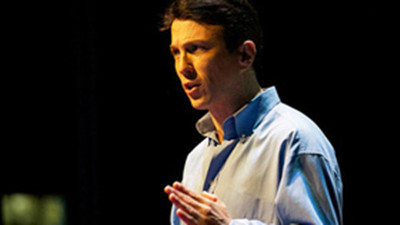We use those in my field of bone marrow transplantation.
我們把這些干細胞用于骨髓移植領域。
Geron, just last year, started the first trial using human embryonic stem cells to treat spinal cord injuries.
杰龍去年開始第一次嘗試用人類的胚胎干細胞治療脊髓疾病。
Still a Phase I trial, but evolving.
仍在試驗階段,但是不斷進展。
We've been actually using adult stem cells now in clinical trials for about 15 years to approach a whole range of topics, particularly in cardiovascular disease.
我們已經應用成體干細胞在臨床試驗大約15年了,在不同的課題,尤其是心血管病。
We take our own bone marrow cells and treat a patient with a heart attack,
我們取出自己的骨髓細胞治療心臟病人,
we can see much improved heart function and actually better survival using our own bone marrow drive cells after a heart attack.
我們可以看到心臟功能改善了并且存活率提高了在心臟病發作后用我們自己的骨髓細胞。
I invented a device called the MarrowMiner,a much less invasive way for harvesting bone marrow.
我發明了一種裝置叫骨髓采集器MarrowMiner,一種溫和得多的收集骨髓的方式。
It's now been FDA approved,and it'll hopefully be on the market in the next year or so.
它已經被FDA認證,將會在一兩年內投放市場。
Hopefully you can appreciate the device there curving through the patient's body and removing the patient's bone marrow,instead of with 200 punctures, with just a single puncture under local anesthesia.
希望你能重視這種裝置,它沿著患者的身體曲線獲取患者的骨髓,以前需要200次穿刺,現在在局部麻醉的情況下只要一次穿刺。
But where is stem cell therapy really going?
但是干細胞治療的前景會怎樣?
If you think about it, every cell in your body has the same DNA as you had when you were an embryo.
如果你考慮一下,身體里的每個細胞有同樣的DNA在你還是胚胎的時候就形成了。
We can now reprogram your skin cells to actually act like a pluripotent embryonic stem cell and to utilize those potentially to treat multiple organs in that same patient making your own personalized stem cell lines.
我們現在能重新構造你的皮膚細胞就像一個多能的胚胎干細胞,利用這種技術可能治療同一個患者的多個器官制造你自己個人化的干細胞系。
And I think they'll be a new era of your own stem cell banking to have in the freezer your own cardiac cells,myocytes and neural cells to use them in the future, should you need them.
我認為這將是你自己干細胞庫的新時代把你自己的心肌細胞存放在冰箱中,還可以是肌肉細胞和神經細胞在你將來需要它們的時候用。
And we're integrating this now with a whole era of cellular engineering,and integrating exponential technologies for essentially 3D organ printing replacing the ink with cells and essentially building and reconstructing a 3D organ.
我們現在集成這些技術作為一整個細胞工程學時代。集成指數技術對于3D器官復制,用細胞替代墨水最終重建一個3D器官。
That's where things are going to head-still very early days.
這是未來的展望;仍然在初始階段。
But I think, as integration of exponential technologies,this is the example.
但是我認為,作為指數技術集成,這是一個例子。
So in close, as you think about technology trends and how to impact health and medicine,we're entering an era of miniaturization,decentralization and personalization.
近期,當你考慮技術趨勢怎樣影響健康和醫學,我們正進入小型化分散化和個性化時代。
And I think by pulling these things together,if we can start to think about how to understand and leverage these,we're going to empower the patient,enable the doctor, enhance wellness and begin to cure the well before they get sick.
我認為把這些特性結合在一起,如果我們能開始思考怎樣了解和利用這些技術,我們將會使患者恢復地更好,醫生更有能力,增強福利防患于未然。

Because I know as a doctor, if someone comes to me with Stage I disease,I'm thrilled-we can often cure them.
因為作為醫生我知道,如果某人在患病初期找到我,我很高興-我們通常能治愈他們。
But often it's too late and it's Stage III or IV cancer, for example.
但是經常太晚了,比方說癌癥3期或者4期。
So by leveraging these technologies together,I think we'll enter a new era that I like to call Stage 0 medicine.
通過集成這些技術,我認為我們將進入一個新時代我愿意叫它零階段醫學。
And as a cancer doctor, I'm looking forward to being out of a job.
作為一名癌癥醫生,我期待失業。
Thanks very much.
非常感謝。
Host: Thank you. Thank you.
主持人:謝謝。謝謝。
Take a bow. Take a bow.
鞠躬。鞠躬。



